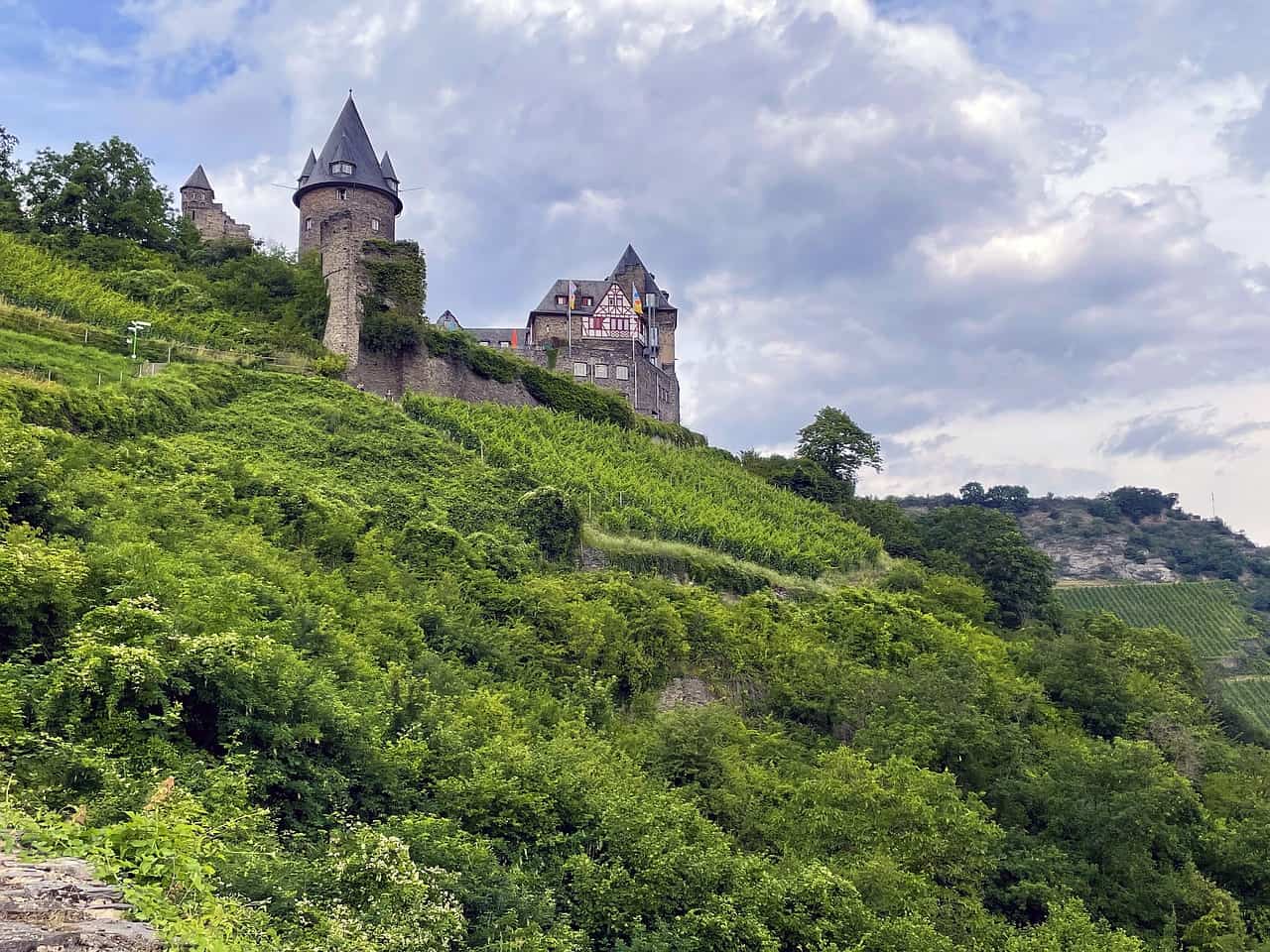Ever dreamed of exploring a real medieval castle perched above the Rhine River? Stahleck Castle in Bacharach delivers jaw-dropping views, centuries of history, and a scenic hike that’s just as rewarding as the destination itself.
Whether you hike up for the panoramic vistas, the romantic ruins of Wernerkapelle along the way, or to peek into one of Germany’s most picturesque castles, this spot is an unforgettable stop on any Rhine Valley itinerary. While the castle now operates as a youth hostel, you don’t have to stay overnight to enjoy everything it offers—from sweeping river views to photo-worthy architecture.
In this post, you’ll learn how to reach Stahleck Castle, what to see along the trail (yes, including that hauntingly beautiful chapel ruin). As a cultural traveler who seeks out history-rich places and hidden gems in Germany, I’ll tell you why this fairytale castle town deserves a place on your German adventure.
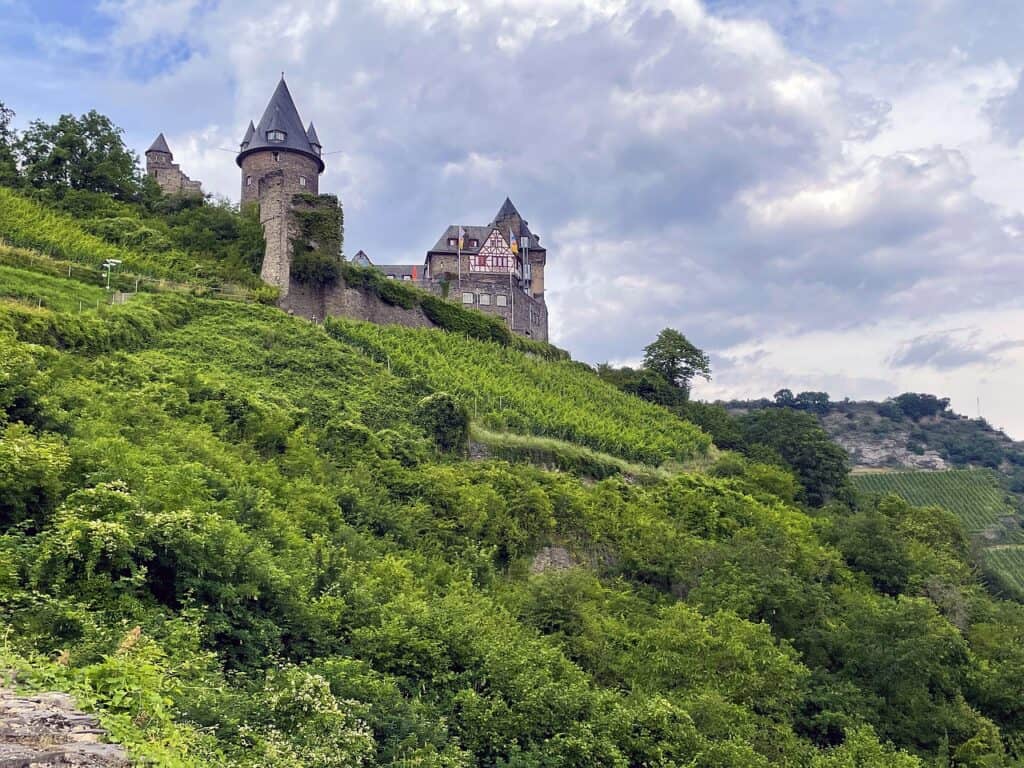
The town of Bacharach itself is like something out of a fairytale. French writer and poet Victor Hugo, who penned The Hunchback of Notre Dame and Les Misérables, once described Bacharach as “one of the most beautiful cities in the world.” High praise indeed! So if you are looking for oodles of German charm, half-timbered buildings, cobblestones, wine cafés, and riverside vistas, Bacharach is the magical place for you!
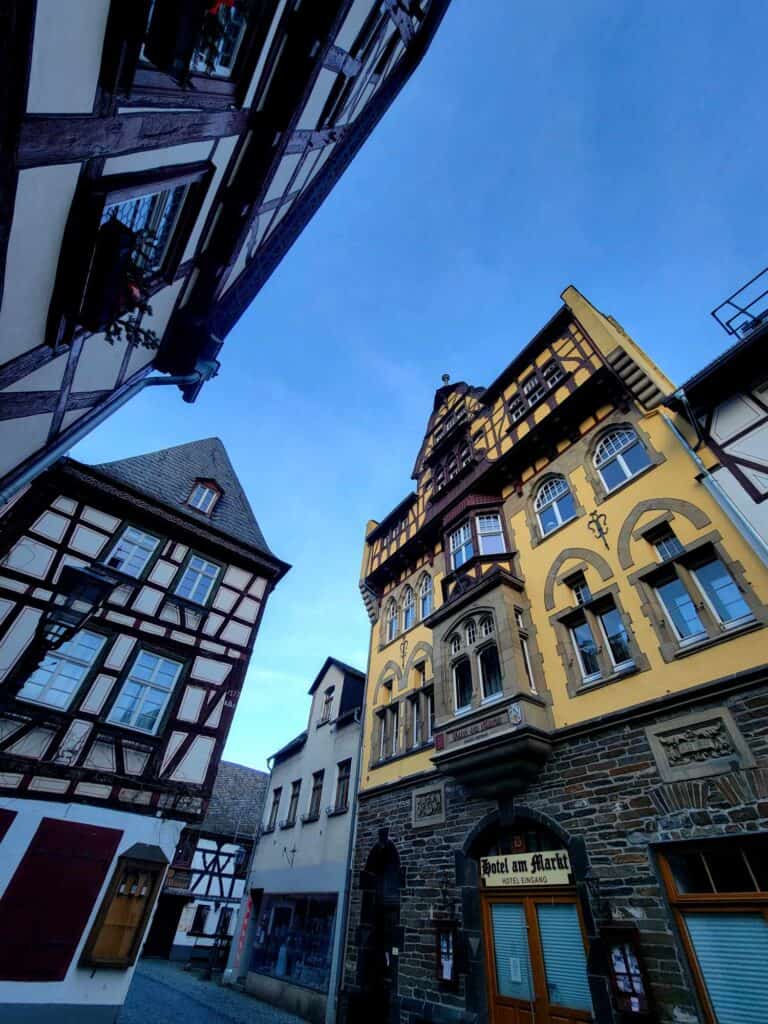
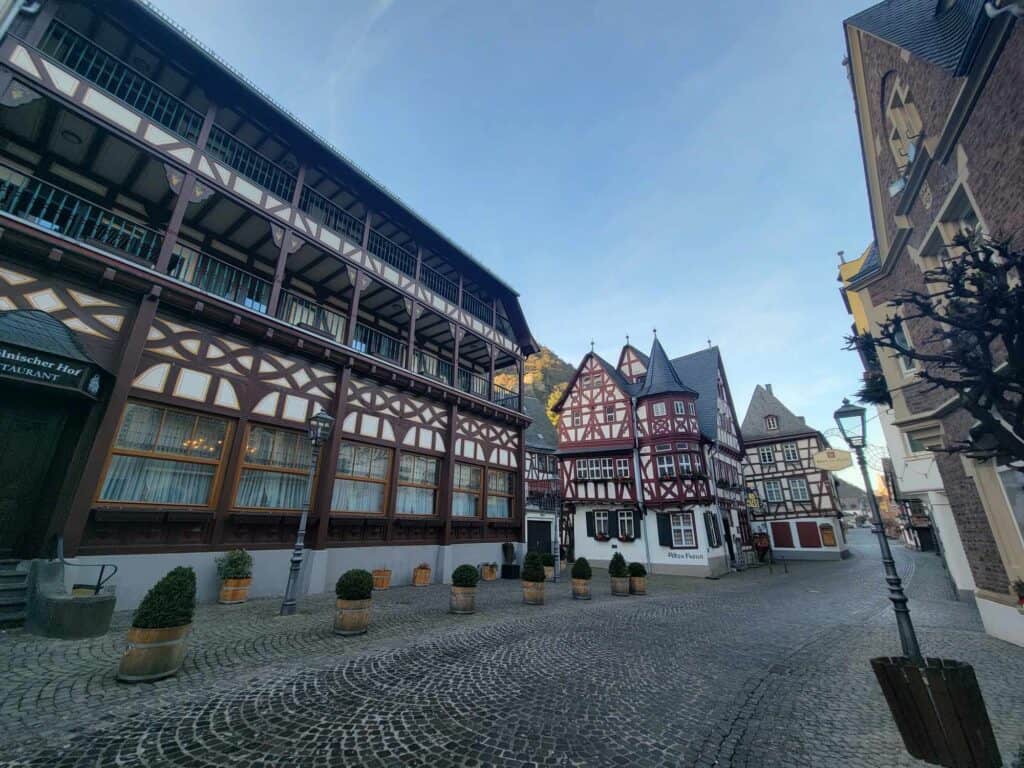
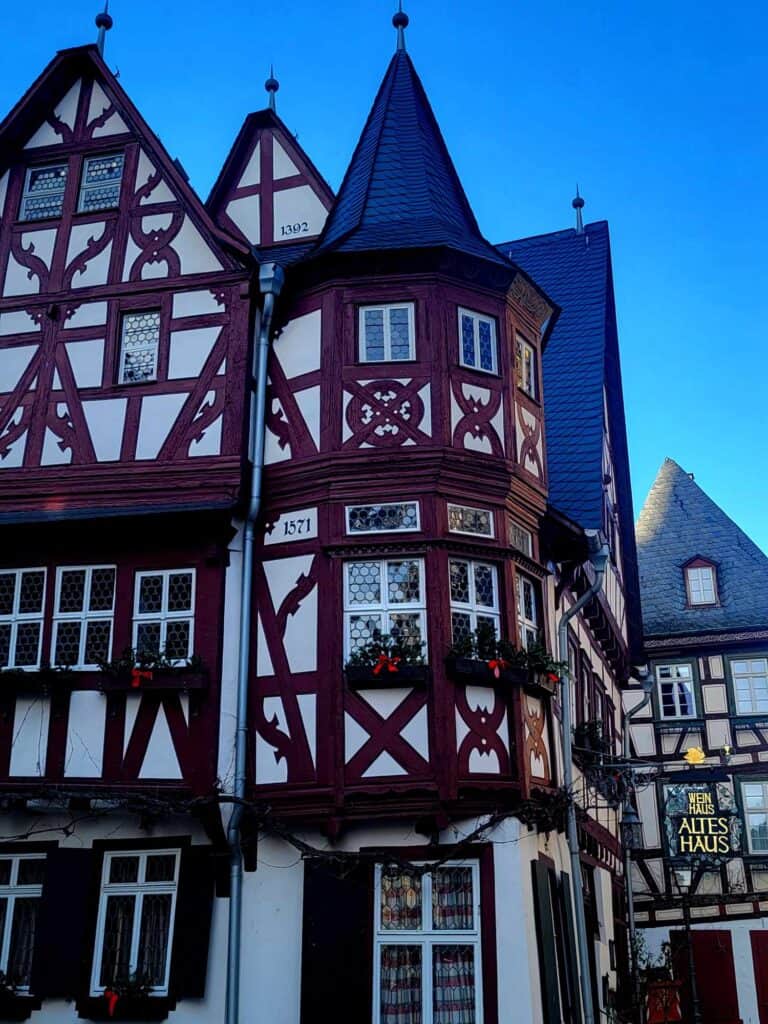
History of Stahleck Castle
Beginnings
By best estimate the construction of the castle began around 1135 for the Archbishop’s governor of Cologne. Stahleck Castle’s original purpose was to be a defensive structure to help the Archbishop assert his authority in that region, and to control the important trade route along the Rhine River. The view from the castle terrace today absolutely made my jaw drop, and I got a good idea of why they chose that location, and how nothing could happen on that section of the Rhine without people in the castle knowing about it! Absolute panoramic bliss!
Middle Ages
In the Middle Ages, Stahleck Castle continued its significant political and military role along the Rhine. Over the centuries it passed through the hands of various noble families through inheritance and marriage. The Counts Palatine of the Rhine beefed up the fortifications and expanded the castle in the 13th century. Their hard work paid off and the fortifications proved to be pretty formidable throughout several conflicts that engulfed the region during that time period.
Elector Palatine Frederick II owned the castle in the 15th century and decided more renovations were in order – but he took it in a different direction. He converted the castle into quite a luxurious residence befitting the refined tastes of Renaissance nobility. Those clunky, inelegant defensive features were partially dismantled, and the interior was zhuzhed up with ornate decoration, frescoes, and lavish furnishings. You see what’s coming…
Thirty Years War
As you can imagine, the “luxury castle era” was short-lived, and soon Stahleck Castle was firmly embroiled in the fierce turmoil of the Thirty Years’ War (1618-1648). The now-less-fortified castle suffered extensive damage and again changed hands multiple times between warring factions. Sadly, it also experienced significant periods of neglect and decay.
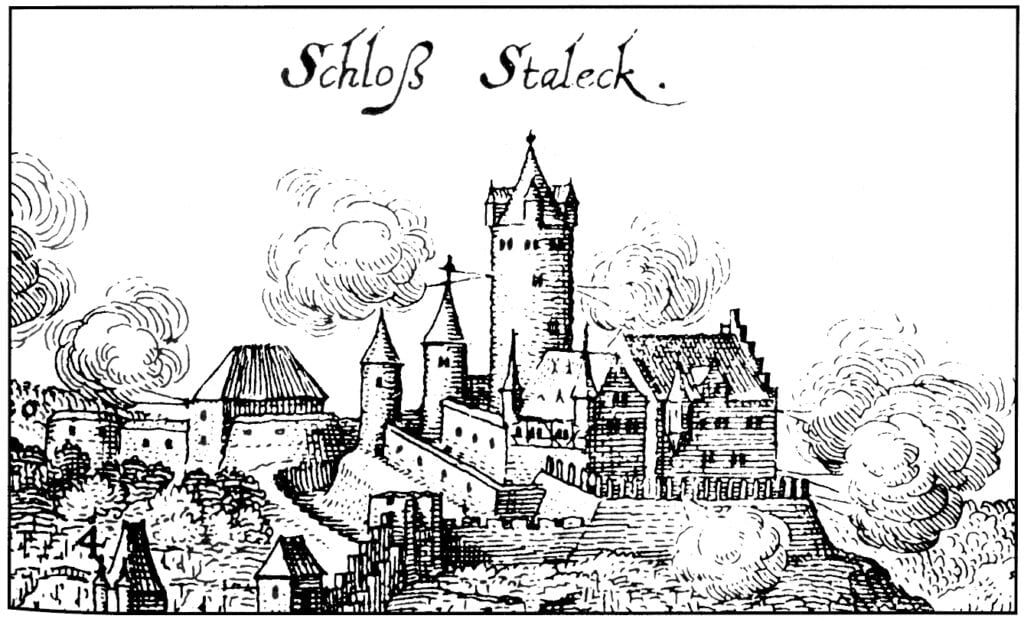
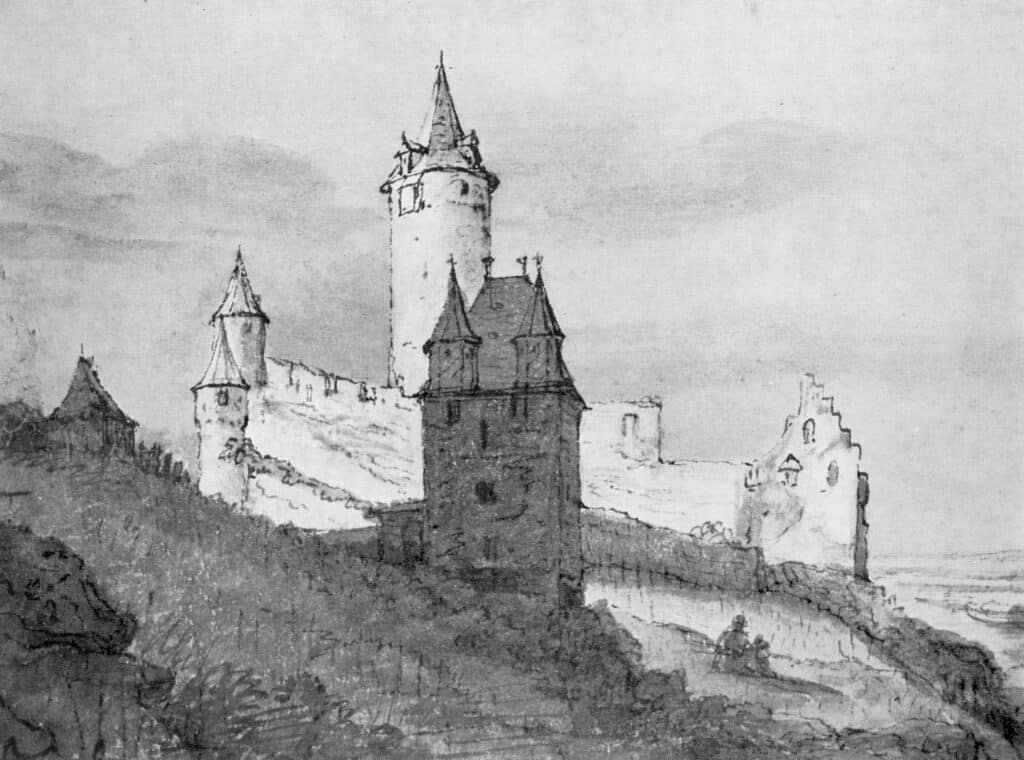
After the war, the battered and broken Stahleck Castle underwent more restorations and renovations, but it never fully regained its former glory. Eventually it became dilapidated and its stones were picked over for use as building materials on other projects. Quarrying stones like that was pretty common, but it always makes me a little sad to think about it.
19th and 20th Centuries
Finally in the late 19th and early 20th centuries, during a time when the public became enamored by the romanticism of the Middle Ages, real efforts were made to preserve and restore the castle. Drawings and etchings from the 1600s, and excavations on site served as reference points for the restoration.
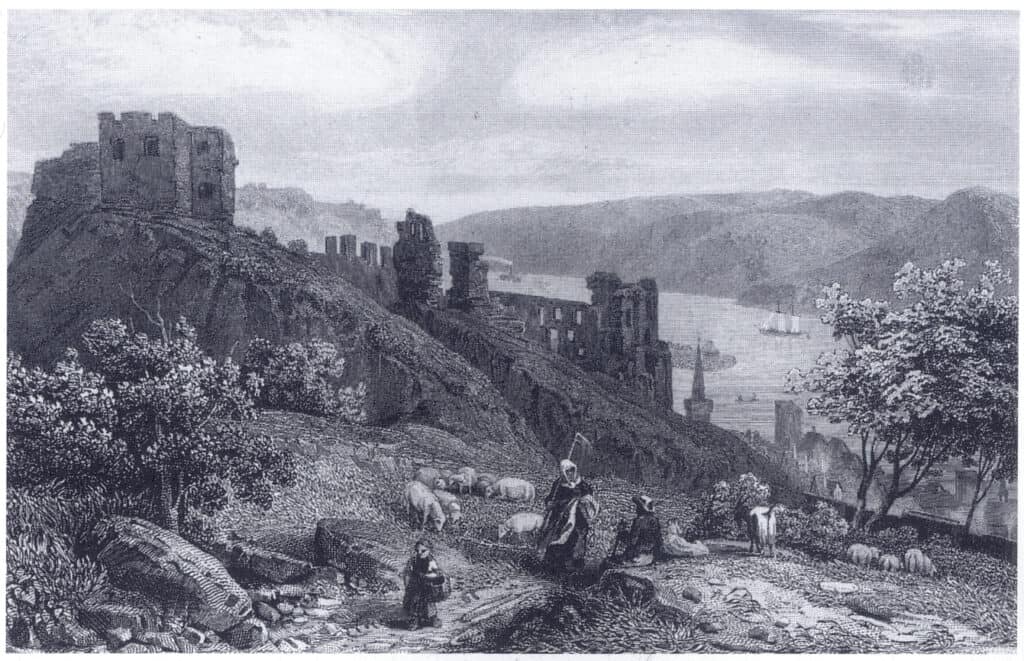
In 1925, Stahleck Castle came into the hands of the German Youth Hostel Association, who completed renovations and transformed it into a youth hostel, making it one of the first of its kind in Germany.
During the dark days of Nazi Germany in the 1930s and 40s, Stahleck Castle became one of 27 “youth castles” used as a “reeducation camp” for the indoctrination of older children and young adults.
Eventually it became a full-on male internment camp for those who had demonstrated insufficient loyalty to the Nazi Party, for protesting mandatory military service, and for participating in a general strike. Some were shipped from Stahleck Castle to concentration camps.
It’s a little crazy standing in the castle and thinking about all of its various lives, but this chapter really gave me chills.
It also served at various times in the 1940s as a military hospital, and a work and military training camp to toughen up young men for war.
I was glad there was a memorial plaque to those who suffered atrocities at the hands of the Nazis. The city of Bacharach also has held memorial events, and invited survivors to speak and tell their stories.
Stahleck Castle Today
Today Stahleck Castle is back to happy times, and functions again as a youth hostel. It’s dark past behind it, Stahleck Castle has become a beautiful and very popular hiking destination for travelers who want to explore the gorgeous and historic Rhine River Valley, and for those who want to stay in a medieval fortress!
How to get to Bacharach
🚗 Parking
There are two large parking lots right next to the river as you drive past Bacharach, one on either side of a long, narrow green space. You can park here, find the machine and leave a ticket in your window. You can pay by credit card, or with Euro coins.
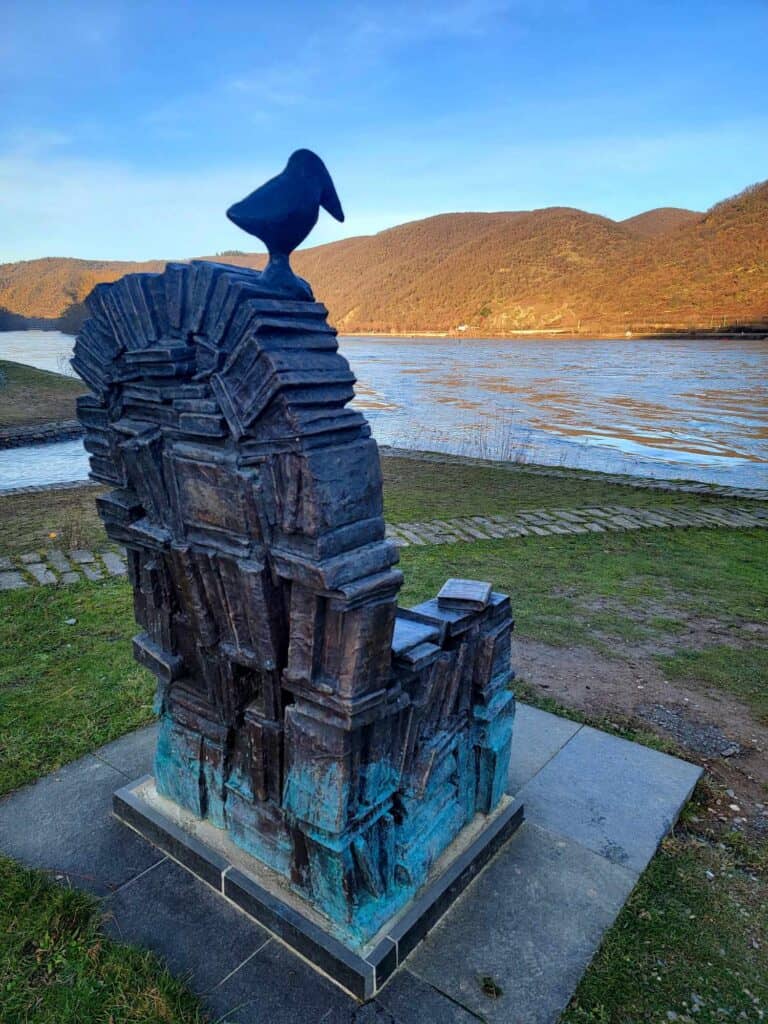
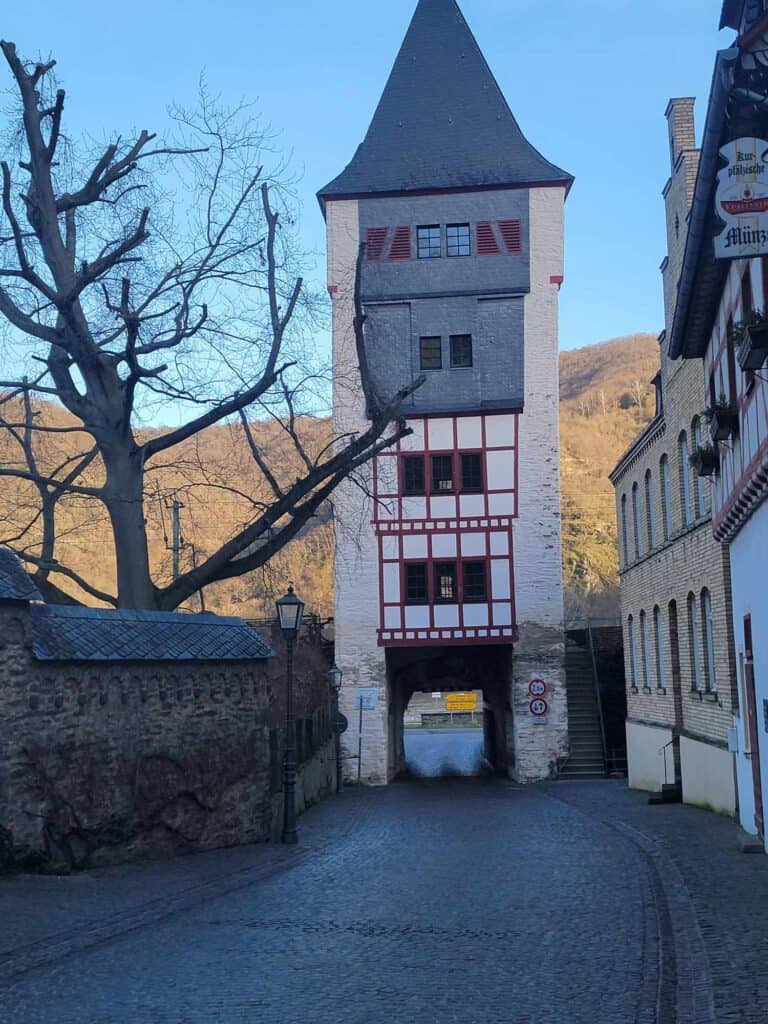
Then, cross the main road, and head into town through a large arched passageway under a square tower. It’s about a 5-minute flattish walk to the center of the old town, and a little further to the trailhead to the castle.
🚊Train
- About 2 hours from Cologne
- About 1 hour 50 minutes from Kaiserslautern
- About 1.5 hours from Frankfurt
- About 35 minutes from Koblenz
The tracks run right along the river. The train station is very close to the center of town, and about a 10-minute walk to the trailhead for Stahleck Castle.
The Trail to Stahleck Castle
Trailhead and Trail Condition
You’ll start right next to St. Peter’s Church which is red and white, right in the center of the old town. You won’t miss it! Then go up the stone steps, and just keep heading uphill. Most of the trail is kept in great condition.
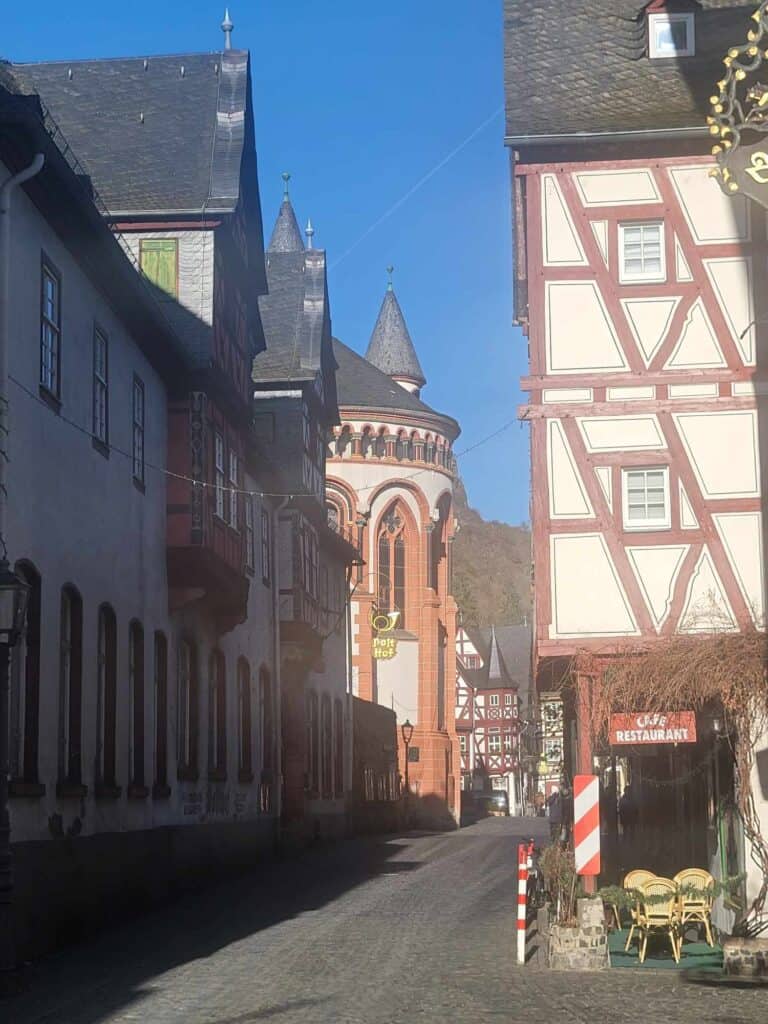

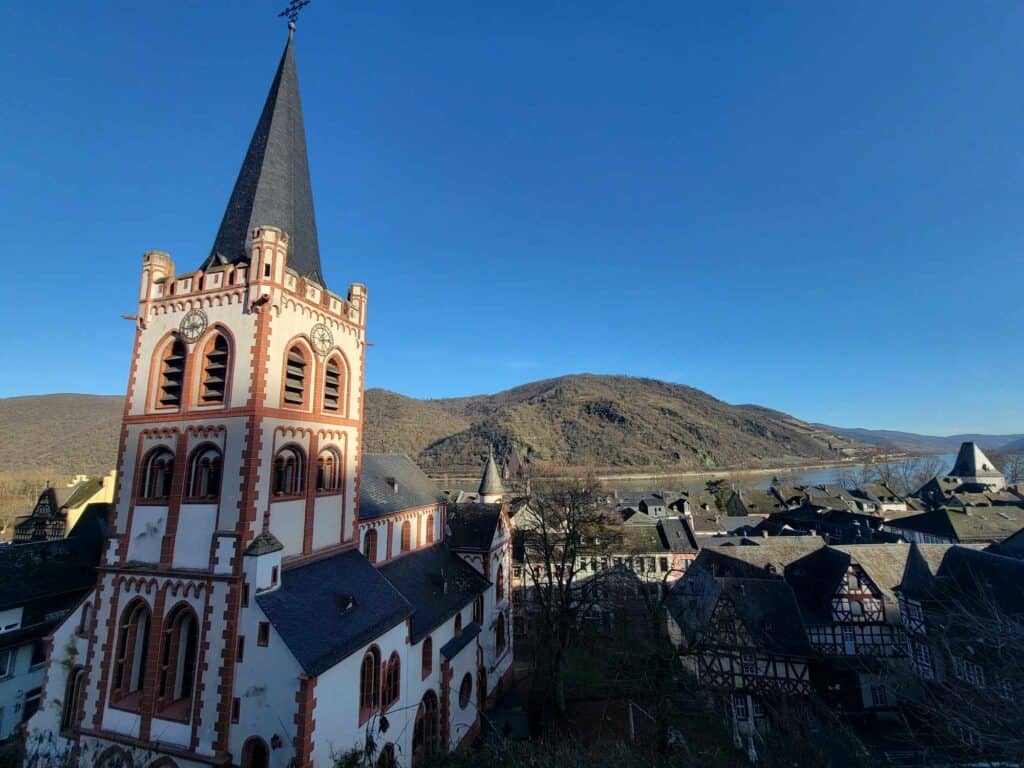
⚠️ On the lower portion is where you’ll need to pay attention. Watch for a few uneven stone steps, some wooden supports with worn or missing areas, and some roots that are definite tripping hazards if you’re looking at all the beautiful stuff around you and not the ground!
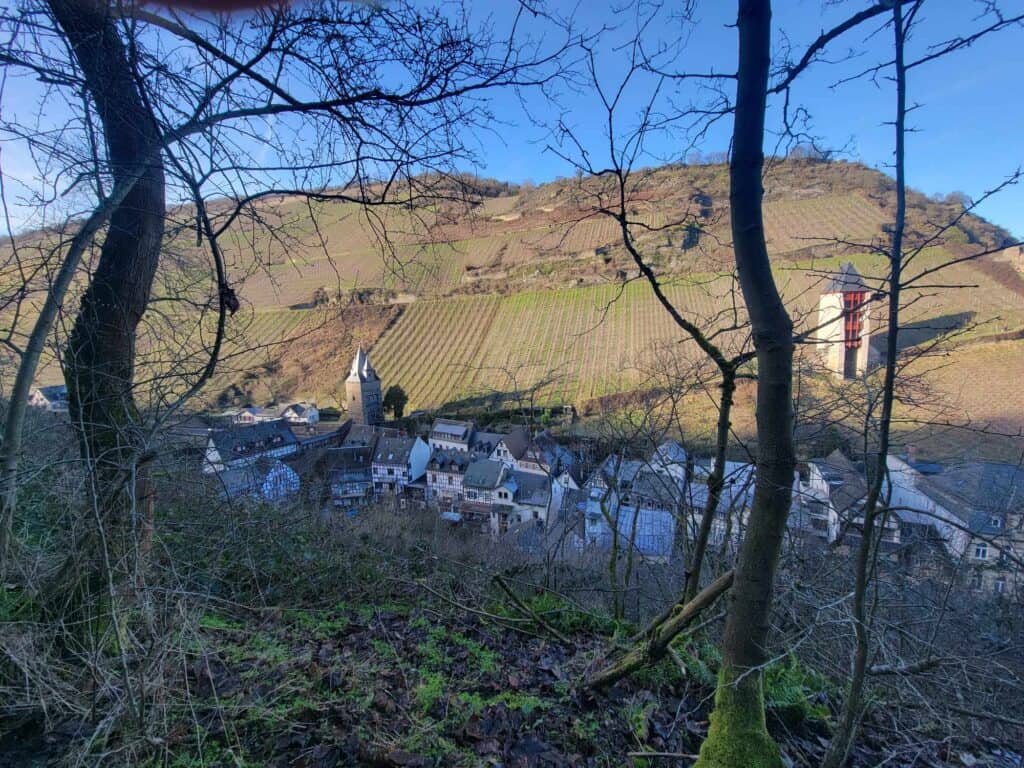
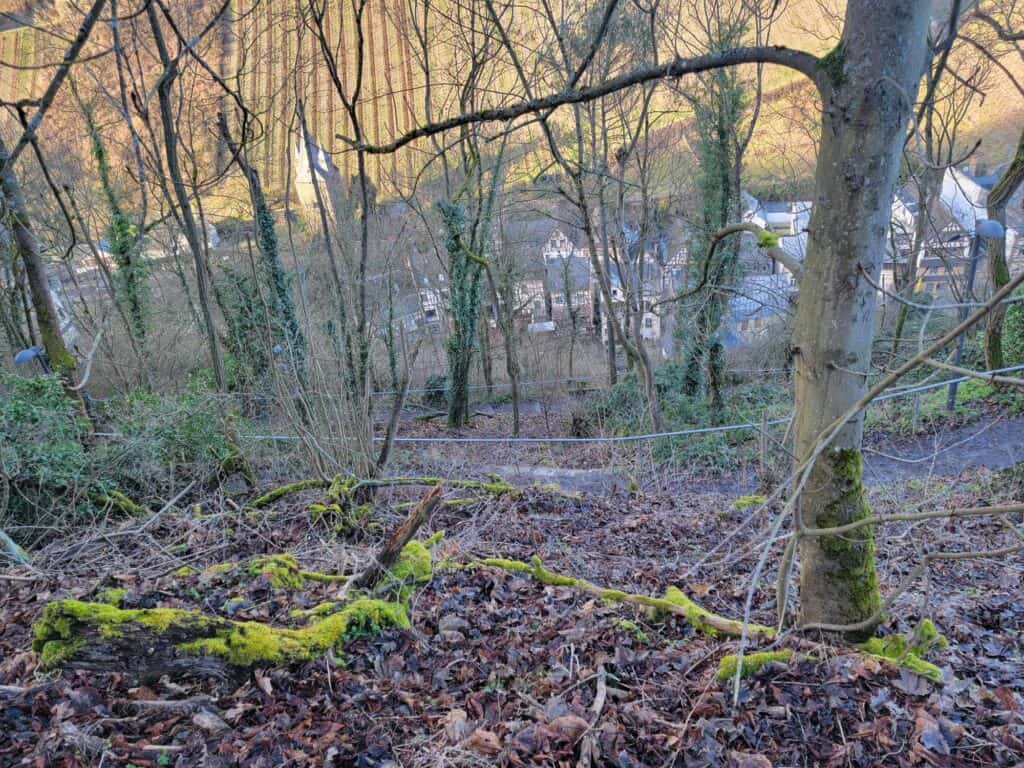
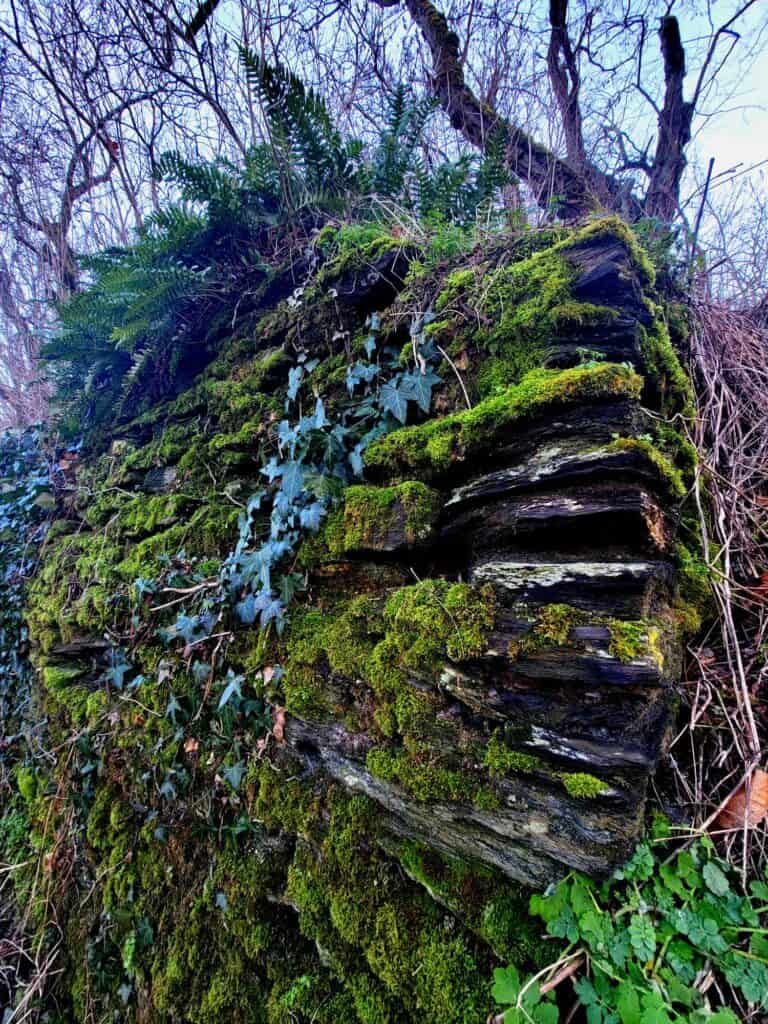
Once you get past all the stairs, you’ll be on a forest path that is kept in great condition.
Werner Chapel
On the way up, and not long after you start up the hill, you’ll see another icon of the town, the Werner Chapel, on your left. This ruin, too, has a dark story.
History and Construction
In 1287 a 16-year old boy was found murdered in Bacharach. His death was wrongly blamed on the local Jewish community. Antisemitic hysteria fueled the rumor that the Jews drank his blood for a Passover celebration. This was the catalyst that initiated a vicious pogrom, wiping out whole Jewish communities from the middle and lower Rhein region. Pockets of further antisemitic violence erupted across Europe.
Every time I hear this type of story, which is all too frequently, it makes my blood run cold. It’s difficult to imagine this kind of fear, hatred, and violence when you’re standing in such a beautiful place – how whole communities were terrorized, run off, or murdered because of misunderstanding, bigotry and fear mongering. As uncomfortable as it is, it’s an important lesson to remember.
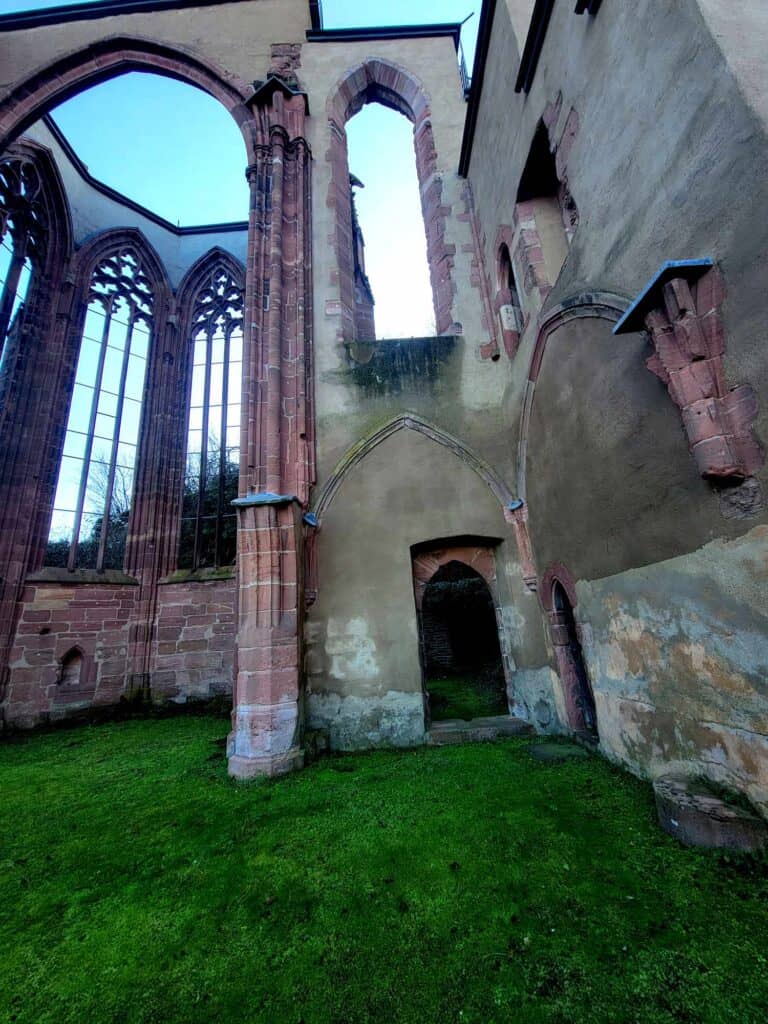
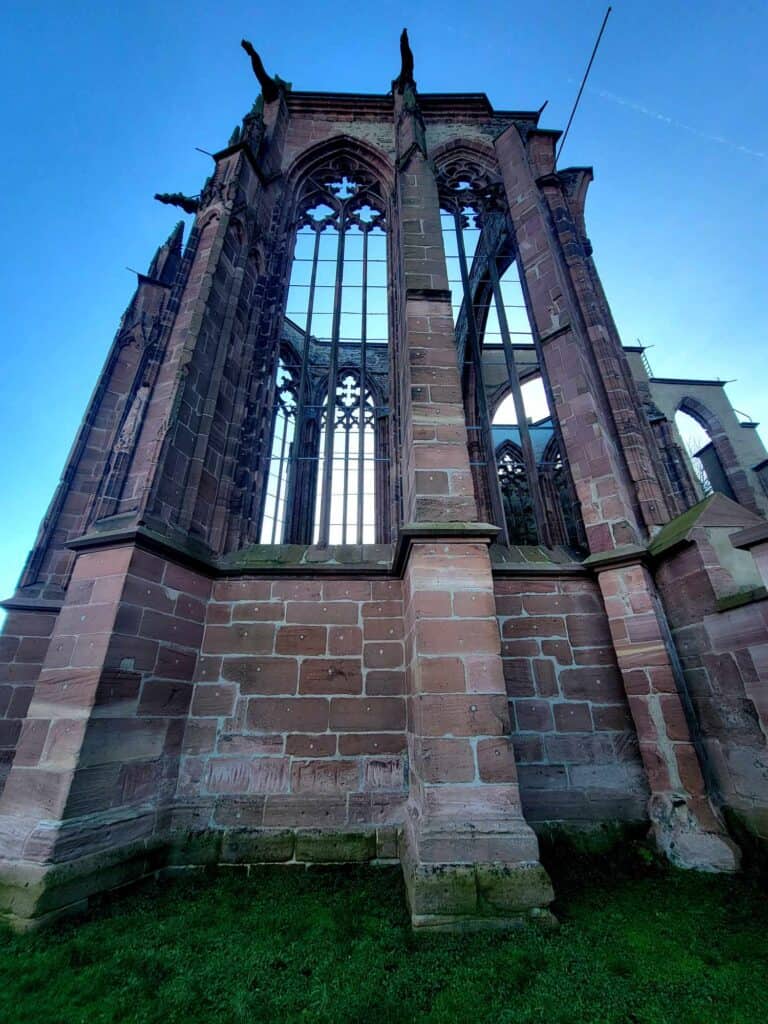
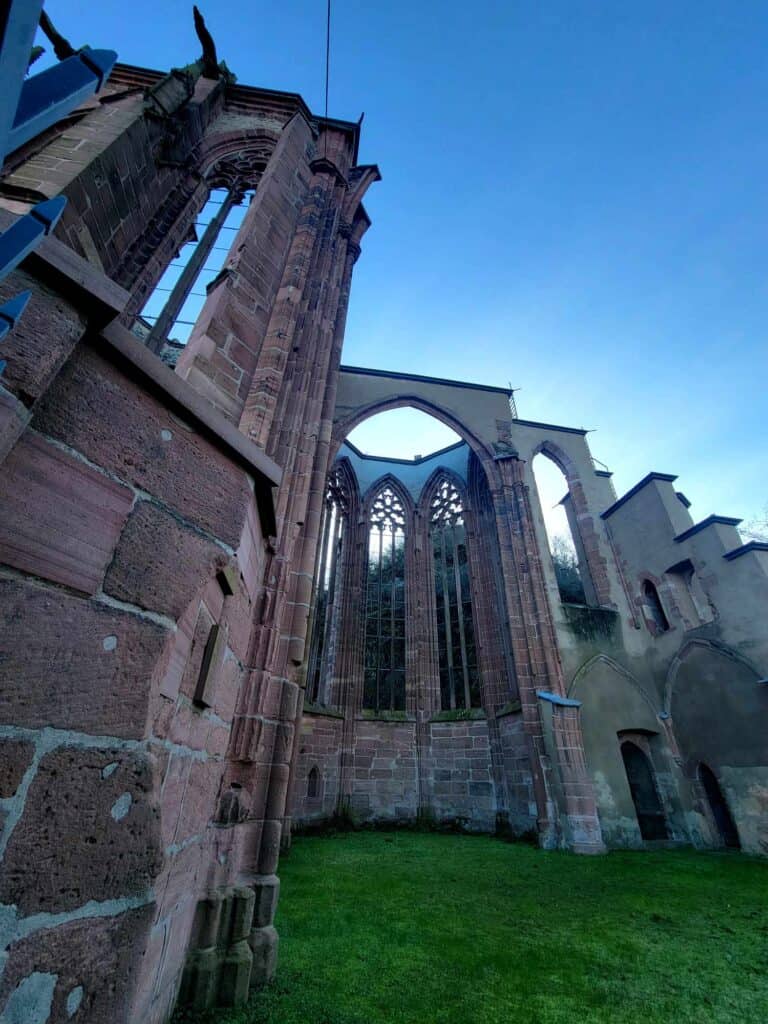
Werner, the murdered boy, became venerated as a martyr and was eventually canonized as a Saint. Werner Chapel was built in his memory. But the story doesn’t end here.
King Rudolph I, convinced that the accusations against the Jews were false, began fining those who murdered Jews (just a fine! 😖) and ordered Werner’s body burned to prevent further veneration. The burning didn’t happen, and there are all kinds of conflicting accounts on this. But reports of miracles fed the growth of a Werner martyr cult.
Destruction
The chapel remained unfinished as the number of pilgrims declined over the years, and the French assault on Stahleck Castle just above the chapel in the 1600s rained boulders down on it, collapsing the roof.
Today
Shockingly, the veneration of Werner didn’t end completely until1963 and the ruined chapel now has signage, serves as a memorial to the innocent Jews who were murdered in the Middle Ages, and tells the full story for visitors.
Length and Slope of the Trail
The trail continues past the Werner Chapel ruins, and becomes more wooded. There are a few switchbacks to ease the uphill slope into something very manageable, but it’s definitely an uphill slog, but with beautiful views along the way.
I counted 356 individual stairs, and 975 steps (including the stairs) each way. It took us a little over half an hour from the bottom to the top, but we stopped at the chapel, and took the rest at a leisurely photo-taking pace.
Can You Stay at Stahleck Castle?
Hostel
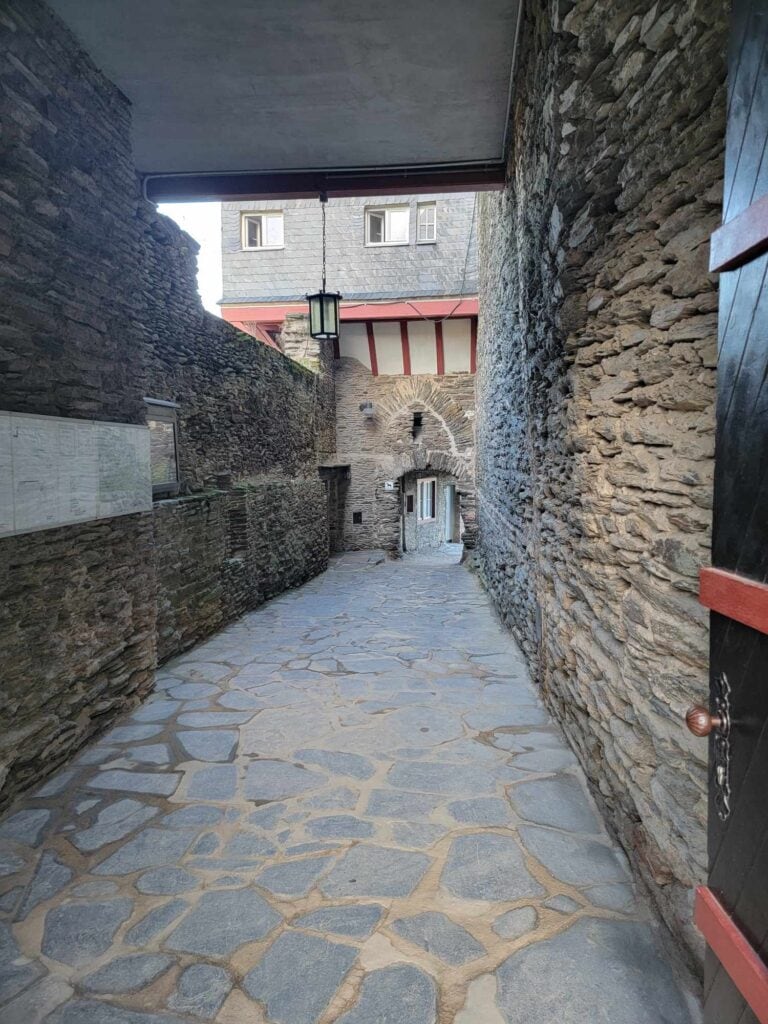
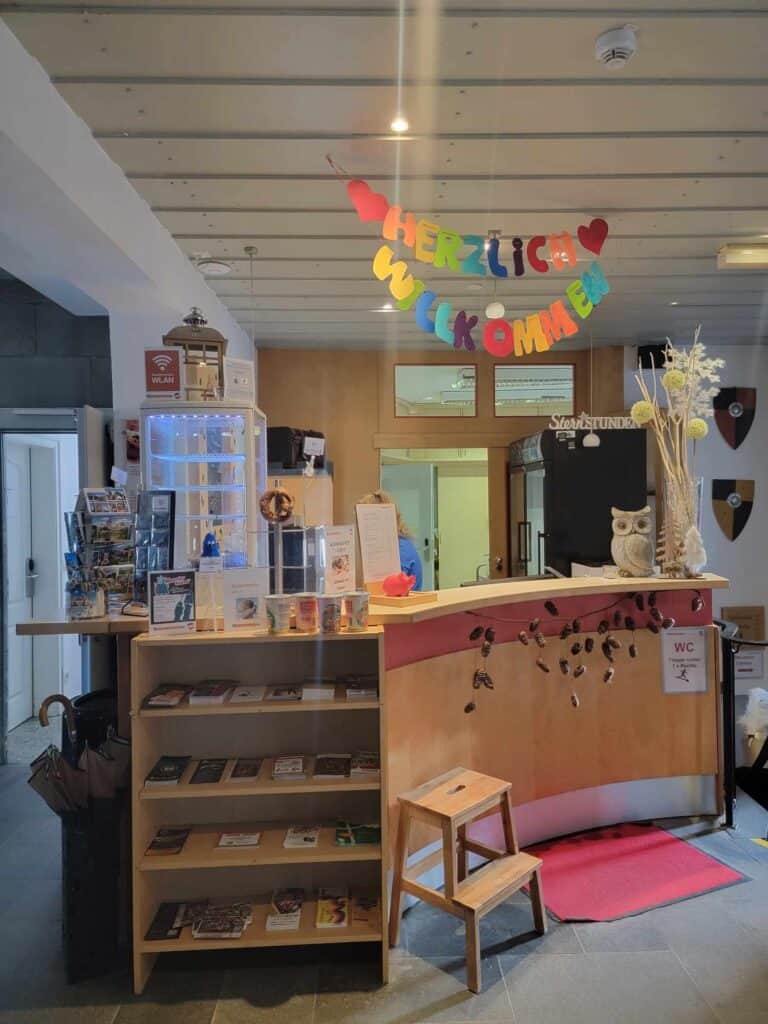
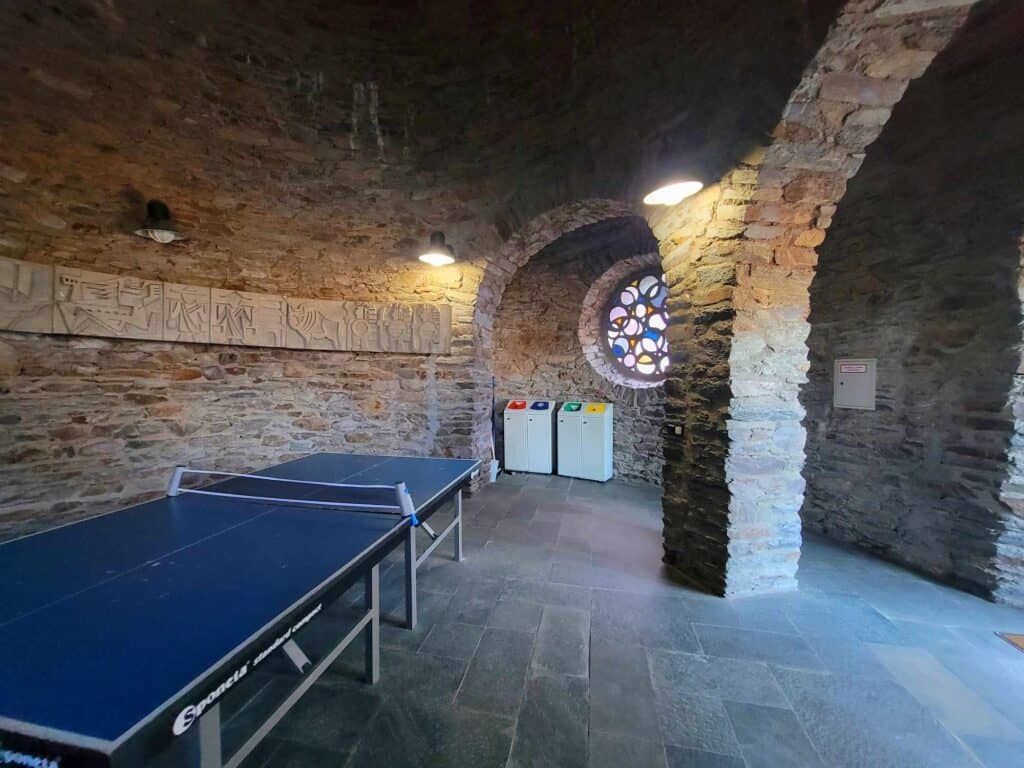
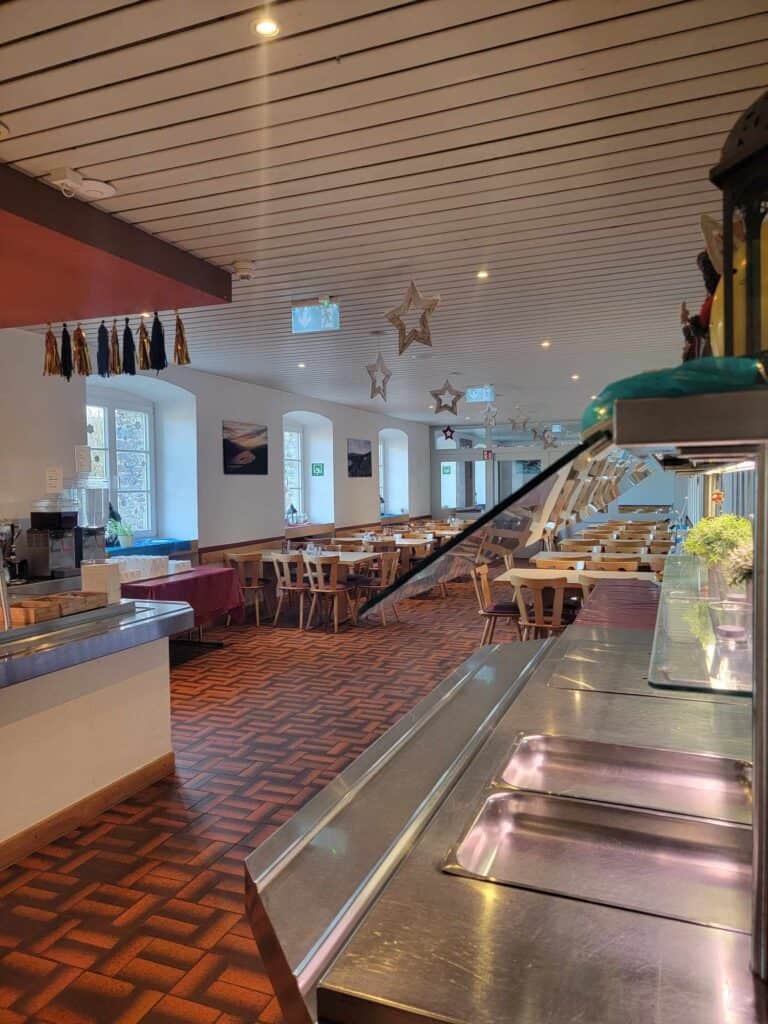
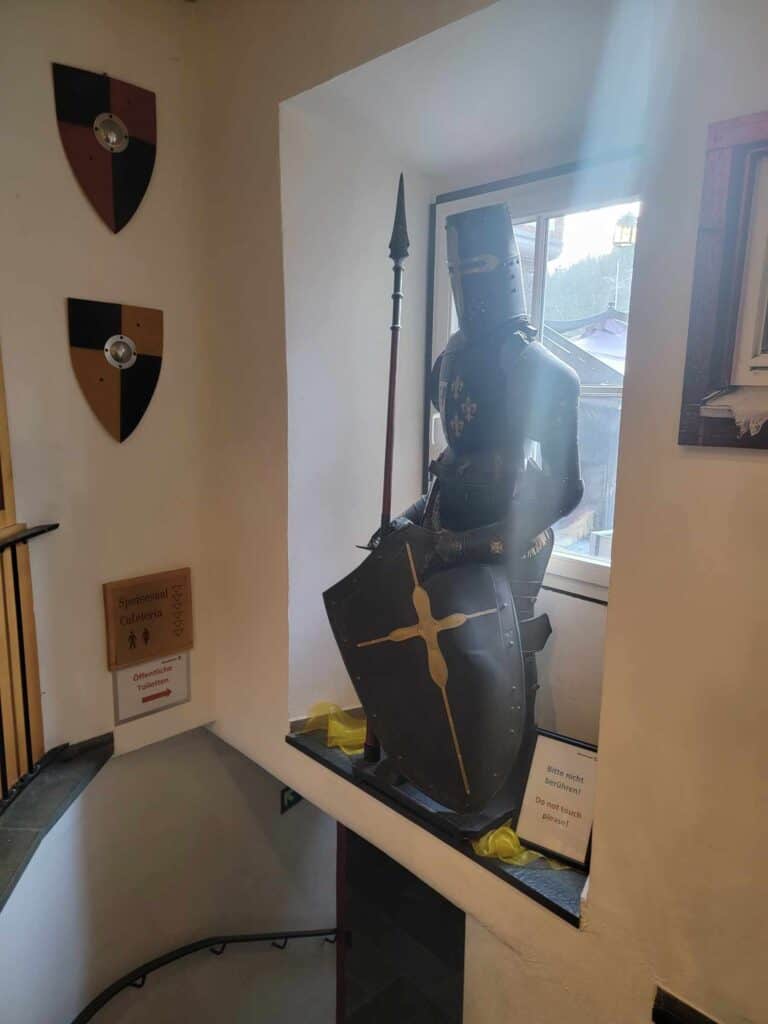
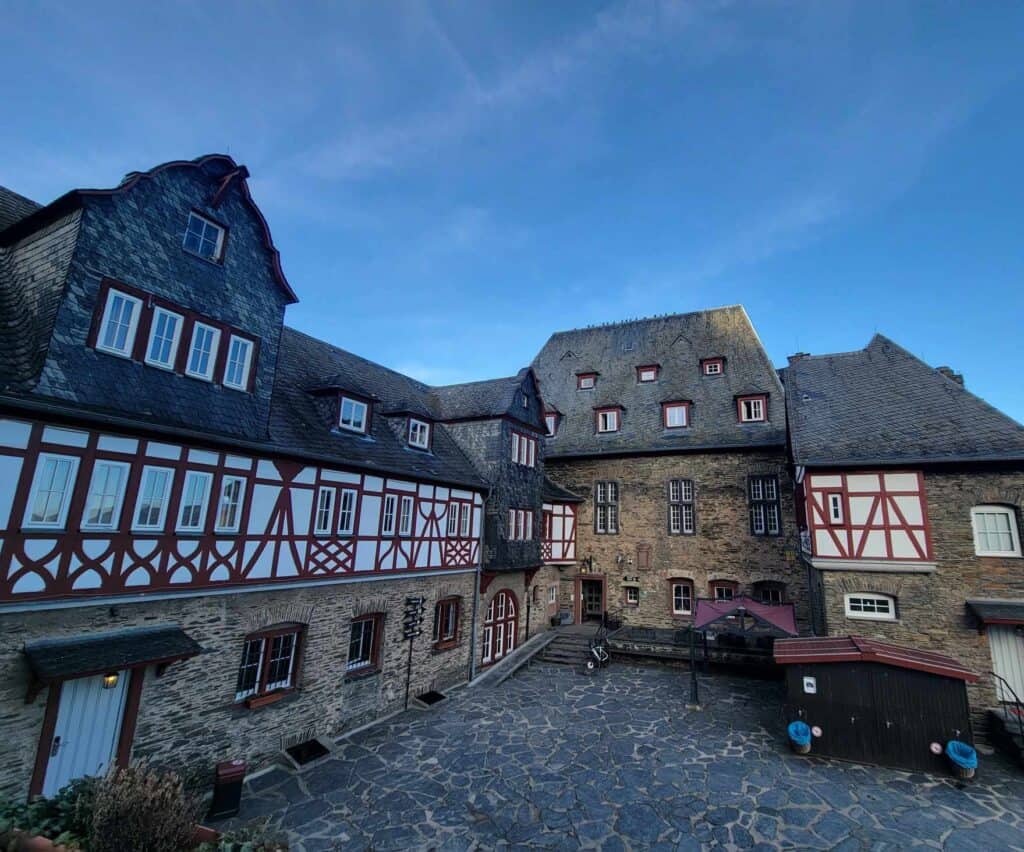
The happy fate of the Stahleck Castle is once more to be a hostel. And yes, you can stay in it! You can find all the particulars at Stahleck Castle Hostel’s official page. Worthy of mention is that they cater to a wide variety of clients including special services for cyclists, families, and groups. They also speak English and German.
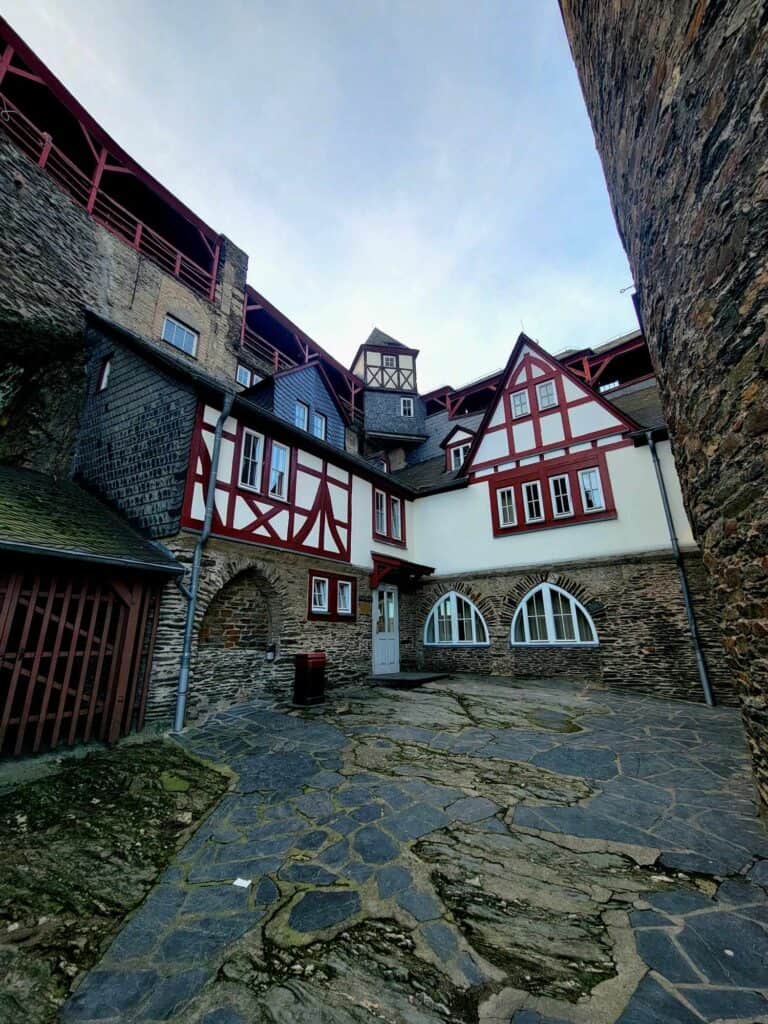
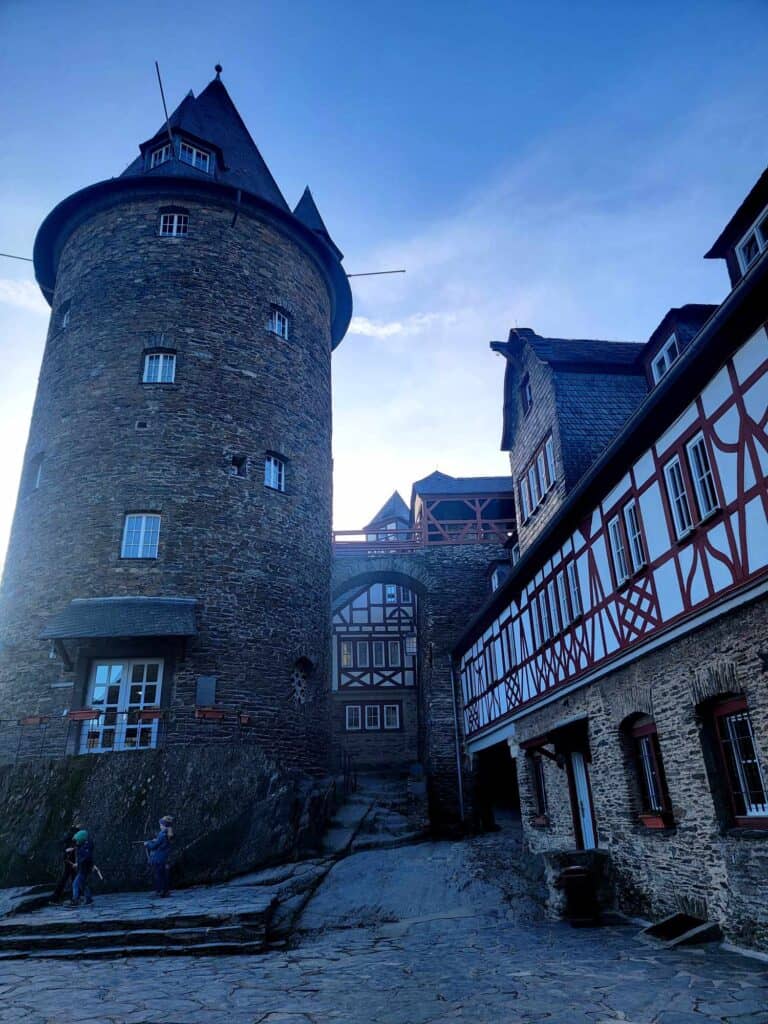
Café
In addition to the dining facility and food service for guests, there is also a bistro serving snacks and drinks. Kaffe und küchen anyone? (That’s ‘coffee and cake’ and the answer is always ‘ja!’)
Restrooms
There are restrooms in the hostel you can use. In the door and down the stairs to your right you’ll find very nice clean facilities.
Viewing platform
A stunning viewing platform and terrace constructed during renovations extends off the courtyard. It’s the perfect spot to spend a lazy hour gazing at the boats passing on the Rhine, enjoying a cool beverage, feeling the breeze, and imagining yourself there at the height of the Renaissance.
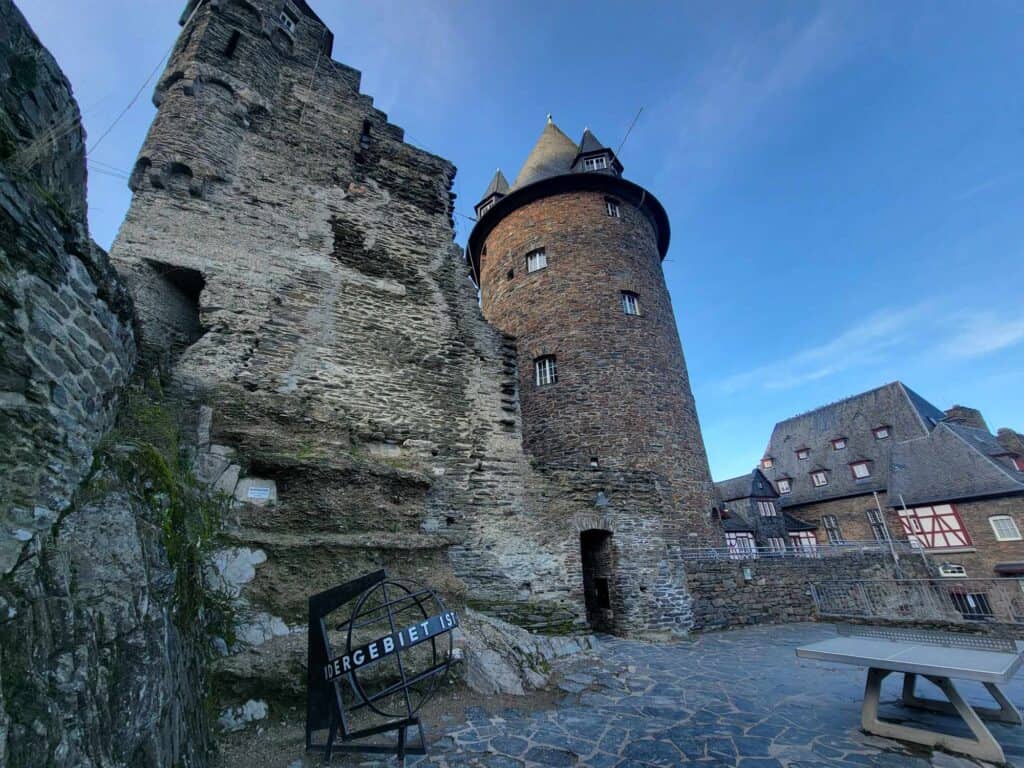
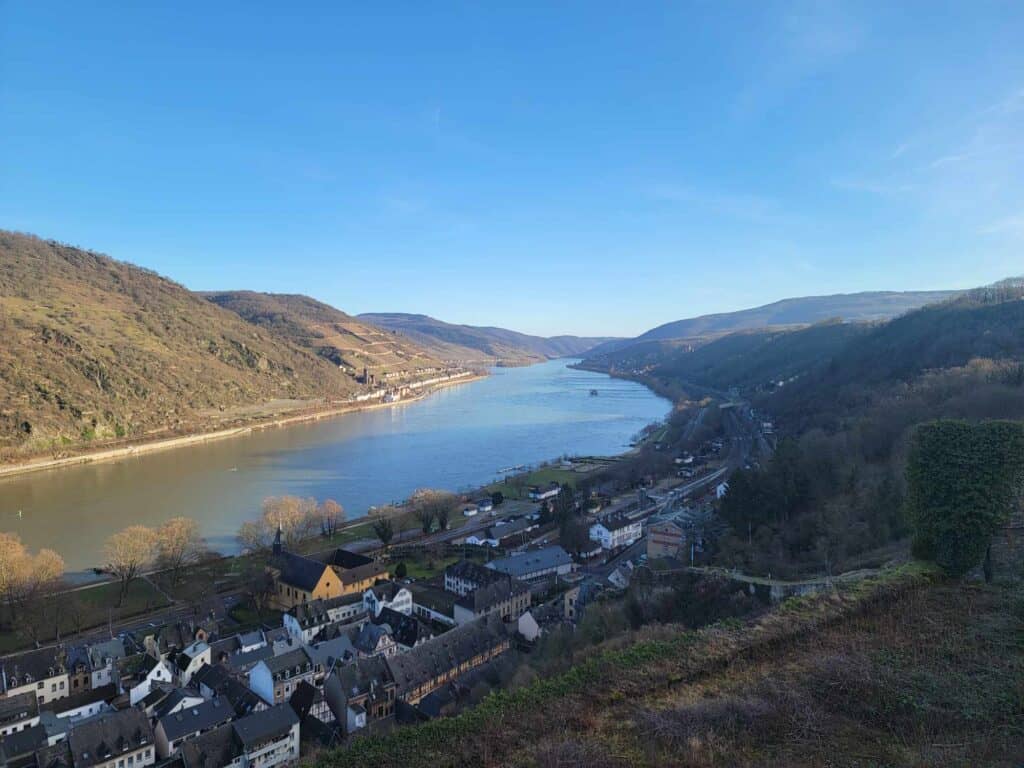
Dog friendliness
If your dog is in good physical shape, you can walk them up to the castle, but dogs are not allowed to stay at the hostel. If you do bring your dog, be sure you have water and a snack for them!
For other fabulous castles in Germany, and more cool things in the area check out these posts:
- One Day in Bacharach: Best Guide to Germany’s Hidden Gem on the Rhine
- Best Place to Stay in Bacharach for a Fairytale Rhine Valley Getaway
- 21 Best Things to Do in Kaiserslautern Germany
- 28 Best Day Trips from Kaiserslautern: Your Ultimate Guide
- Ultimate Guide to Frankenstein Castle in Frankenstein Germany
- Hike to Hohenecker Castle in Kaiserslautern Germany
- Explore Fascinating Nanstein Castle in Landstuhl Germany
- Discover Charming Hohenbaden Castle Overlooking Baden-Baden
- Explore the Astounding Schlossberg Caves and Castle Ruins in Homburg
- A Real-Life Fairytale Castle in Germany – Discover Miraculous Burg Eltz
- Saarbrücken Castle – Explore This Fascinating Underground World
- Dinopark in Kaiserslautern: Great Fun for Everyone at the Gartenschau
- Lowenburg Castle – The Remarkable Story of a Medieval Castle that Isn’t!
- Your Ultimate Guide to Visiting Nuremberg Castle: History, Tips & Must-Sees
